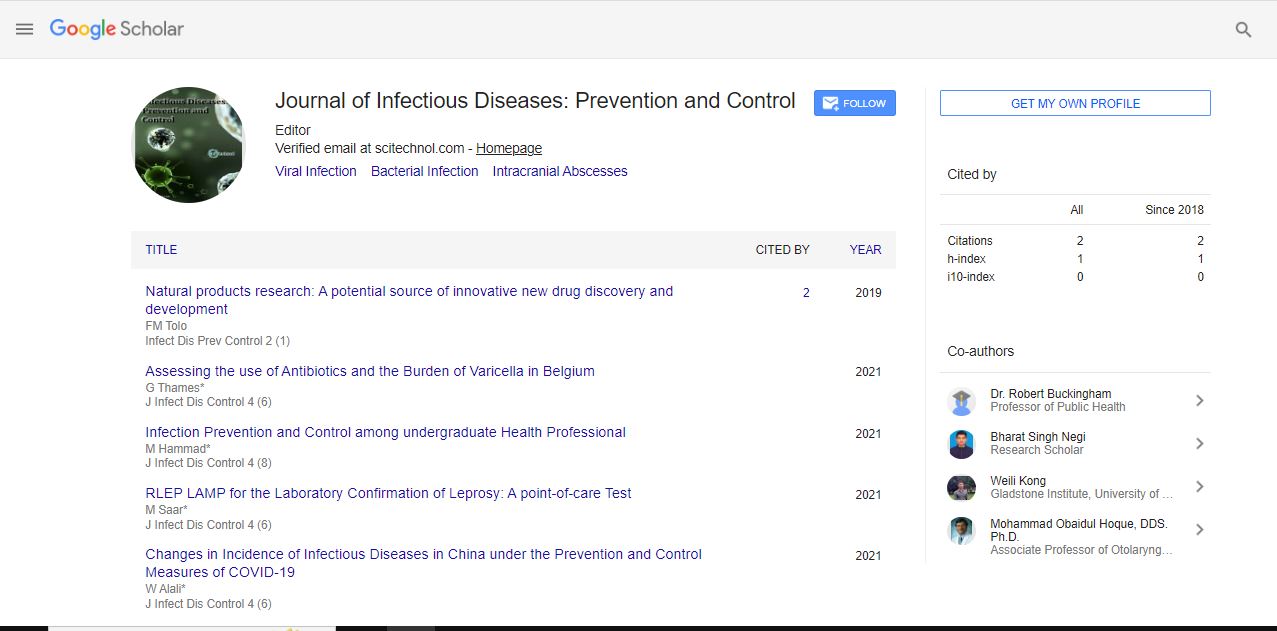Perspective, Vol: 6 Issue: 1
Bacterial Infection Pathogenesis: An Overview of Pathophysiology
Irfa Musthafa*
1Department of Radiodiagnosis and Imaging, Shahid Gangalal National Heart Centre, Kathmandu, Nepal
*Corresponding Author: Irfa Musthafa
Department of Radiodiagnosis and
Imaging, Shahid Gangalal National Heart Centre, Kathmandu, Nepal;
E-mail: irfatish123@gmail.com
Received date: 21 February, 2023, Manuscript No. IDPC-23-95695;
Editor assigned date: 23 February, 2023, Pre QC No. IDPC-23-95695(PQ);
Reviewed date: 07 March, 2023, QC No. IDPC-23-95695;
Revised date: 14 March, 2023, Manuscript No. IDPC-23-95695(R);
Published date: 24 March, 2023, DOI: 10.36648/idpc.5.2.126
Citation: Musthafa I (2023) Bacterial Infection Pathogenesis: An Overview of Pathophysiology. Infect Dis Prev Control 6:1.
Description
Bacterial infections are caused by harmful microorganisms that invade the human body, causing various health problems ranging from mild to severe. Bacteria are present everywhere, including in the air, soil, water, and human body. While some bacteria are essential for maintaining good health, others can cause infections when they enter the body. Bacterial infections can occur in various parts of the body, including the skin, throat, lungs, urinary tract, and digestive system. Some of the most common bacterial infections include strep throat, urinary tract infections, pneumonia, and bacterial meningitis. These infections can be serious and require immediate medical attention.
Causes of bacterial infections
Bacterial infections are caused by harmful bacteria that enter the body through various means.
Direct contact: Bacteria can be transmitted from person to person through direct contact, such as kissing, sexual contact, or sharing personal items like towels or razors.
Indirect contact: Bacteria can also be transmitted through indirect contact, such as touching contaminated surfaces or objects like doorknobs, keyboards, or telephones.
Ingestion: Bacteria can enter the body through the ingestion of contaminated food or water.
Inhalation: Bacteria can enter the body through the inhalation of contaminated air or droplets, such as when an infected person coughs or sneezes.
Inhalation: Bacteria can enter the body through the inhalation of contaminated air or droplets, such as when an infected person coughs or sneezes.
The symptoms of bacterial infections vary depending on the type of infection and the part of the body that is affected. However, some common symptoms of bacterial infections include.
Fever: Fever is a common symptom of bacterial infections, indicating that the body is fighting an infection.
Pain or discomfort: Bacterial infections can cause pain or discomfort in various parts of the body, including the throat, chest, stomach, and urinary tract.
Fatigue: Bacterial infections can cause fatigue, weakness, and lethargy, making it difficult to carry out daily activities.
Nausea and vomiting: Some bacterial infections can cause nausea and vomiting, especially those affecting the digestive system.
Diarrhea: Bacterial infections can cause diarrhea, which can lead to dehydration if left untreated.
Skin Rash: Some bacterial infections can cause a rash on the skin, which may be accompanied by itching or burning.
Difficulty breathing: Bacterial infections affecting the lungs can cause difficulty breathing, chest pain, and coughing.
Treatment of bacterial infections
The treatment of bacterial infections depends on the type and severity of the infection. Antibiotics are the most common treatment for bacterial infections, but they are not effective against all types of bacteria. It is important to seek medical attention if suspect have a bacterial infection, as untreated infections can lead to serious complications.
Antibiotics: Antibiotics are medications that kill or inhibit the growth of bacteria. They are the most common treatment for bacterial infections. However, antibiotics are not effective against all types of bacteria, and they can have side effects.
Antiviral medications: Antiviral medications are used to treat some types of bacterial infections, such as viral meningitis.
Pain medications: Pain medications may be prescribed to relieve pain or discomfort associated with bacterial infections.
Intravenous fluids: Intravenous fluids may be given to treat dehydration caused by bacterial infections.
Surgery: Surgery may be necessary to remove infected tissue or drain abscesses caused by bacterial infections.
 Spanish
Spanish  Chinese
Chinese  Russian
Russian  German
German  French
French  Japanese
Japanese  Portuguese
Portuguese  Hindi
Hindi 